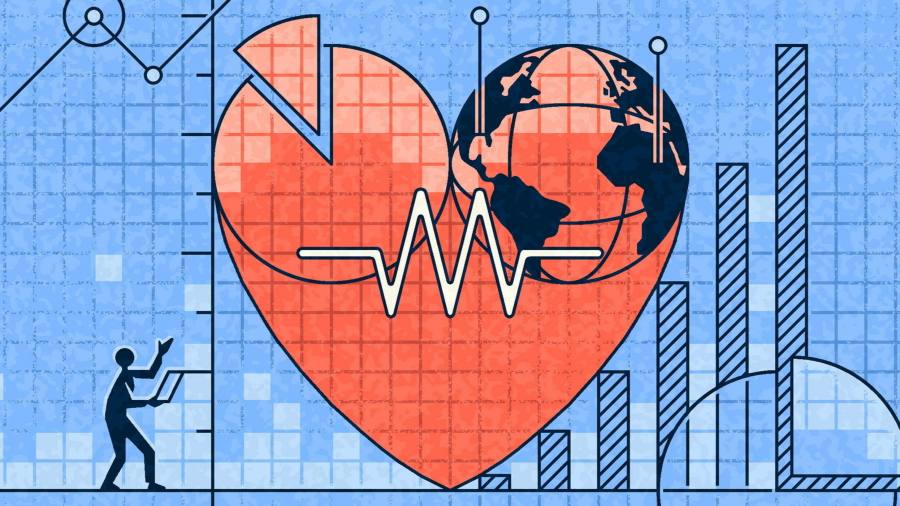Receive free Global Economy updates
We’ll send you a myFT Daily Digest email rounding up the latest Global Economy news every morning.
Every now and then a “feel good” story pops up on American morning TV that would make most Europeans spit out their tea in horror.
Good Morning America, for instance, ran a piece about a “trendy co-worker baby shower gift”: donating some of your limited paid leave to your pregnant colleague, so she can have a little longer with her newborn before returning to work. One woman said she was grateful to have a whole 12 weeks with her baby before returning to her job, thanks to leave donated by her colleagues. Another TV station told the tale of medical staff who donated their paid time off during the pandemic to a colleague who had leukaemia.
These aren’t one-offs. Roughly a quarter of US employers have a “paid time off donation programme”, according to a poll by the American Society of Employers. One university, for example, gives its workers “the opportunity to donate accrued vacation . . . to fellow employees who have experienced a catastrophic illness or injury and who have exhausted all accrued time”.
People are donating their leave to each other because the US system is so miserly in this regard. America has no statutory entitlement to paid maternity leave or paid sick leave at the national level. It’s hard to overstate how much of an outlier this makes it among rich countries. On average across OECD countries, mothers are entitled to almost 19 weeks of paid maternity leave. I took off about a year when I had a baby in the UK, most of which was paid.
I think about disparities like this whenever I hear Europeans fret that their continent is falling behind the US in terms of economic might. It’s not that GDP doesn’t matter, but is it really the only yardstick by which countries should jealously compare their progress against one another?
This is hardly a new question. People have argued for decades that GDP is an insufficient measure of national prosperity or living standards, but attempts to come up with something better tend to end up rather mushy. The trouble is, once you start to think about which factors are important, it’s hard to know when to stop. The OECD’s Better Life index has 11 different indicators. Not to be outdone, the UK’s Office for National Statistics has 44 indicators of “national wellbeing”, from participation in sports to levels of trust in government. Before you know it, you’re looking at a dreaded “dashboard” which, while full of perfectly interesting information, makes it hard to tell what’s going on overall, let alone how one country compares with another.
It would be better to make it simple. For my money, life expectancy is the most important supplementary measure of how a country is doing. It is a solid quantitative metric based on mortality rates, and few things matter more than life and death. It is also influenced by other factors people care deeply about, such as the treatment of babies and mothers, the quality of food, healthcare, education, pollution, jobs and crime. One could argue that “healthy life expectancy”, a measure of the years people live in decent health, would be even better, but the data available right now is too subjective to compare trends robustly across countries.
Of course, policymakers do care about life expectancy already. But what might the world look like if politicians compared these statistics as obsessively and anxiously as they do their GDP trends? By this measure, the US would not be envied by the rest of the rich world. Even as its economy grows, the life expectancy of its people falls further behind that of its peers. In 1980, life expectancy was roughly the same in the US as it was in Italy and France, and higher than in the UK and Germany. It had sunk to the bottom of that pack by the 1990s, and now it is being overtaken by much poorer countries in terms of GDP per head. For all the ink spilled about when (or if) Chinese GDP will overtake America’s, Chinese life expectancy has already quietly achieved that feat.
None of this is to say that GDP doesn’t matter. It represents the size of pie, which helps to determine what a country can do in the world, as well as the kind of life it can provide for its people. Unsurprisingly, then, GDP per head and life expectancy tend to roughly correlate, but there are plenty of exceptions from which lessons can be learnt. Some countries punch above their economic weight when it comes to life expectancy, such as Spain, Italy and Japan with their healthy diets. The US, with its guns, processed foods and poor safety net, punches well below.
People who care about health and want to influence policymakers or the public often try to highlight the impact it has on the economy. “Poor health reduces global GDP by 15 per cent each year,” one McKinsey study claims. “Endemic ill-health in England’s “left behind” neighbourhoods costs the country almost £30bn a year because people are often too ill to work and die earlier” another report suggests. But this is to get things precisely backwards. We don’t want to live long and healthy lives so we can generate GDP, we want GDP so we can live long and healthy lives.
There’s nothing wrong with a bit of healthy competition between countries. But when it comes to economic growth, let’s not confuse the means with the ends.
Read the full article here




